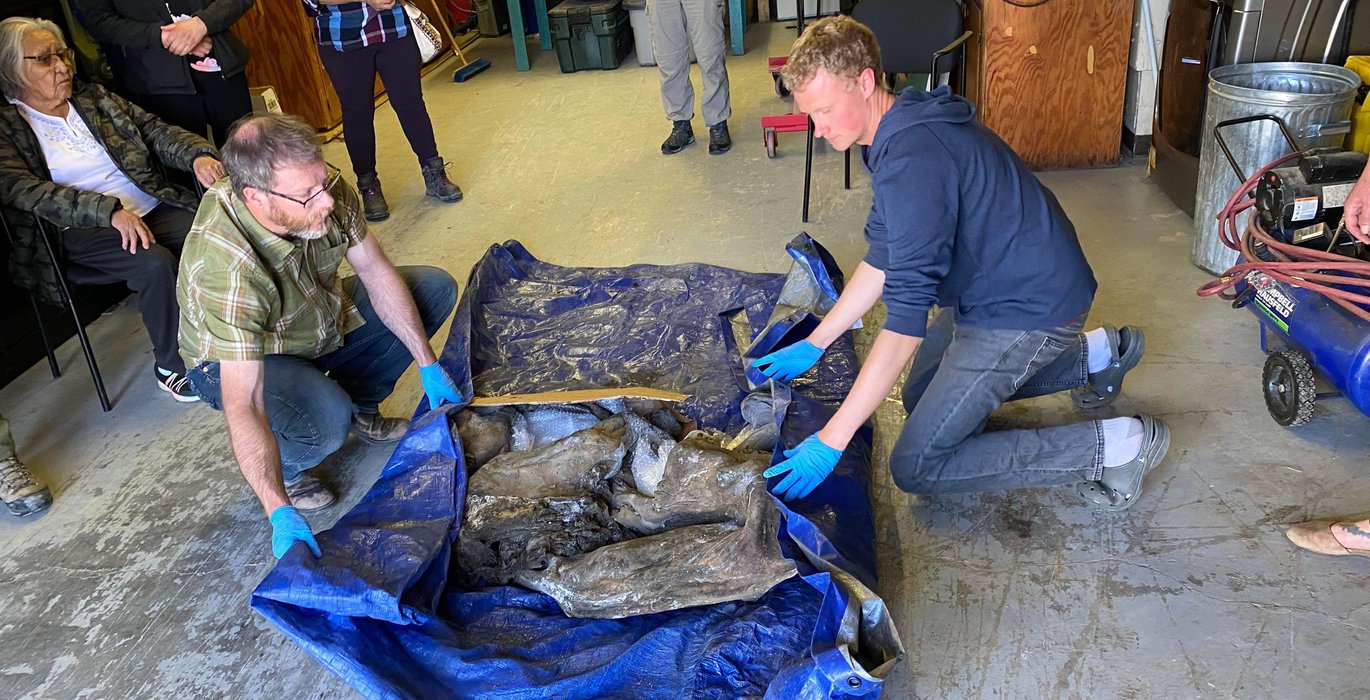
It was a real eureka moment at Eureka Creek near Yukon’s Dawson City when miners unearthed something even more precious than gold–a nearly complete, impeccably preserved mummified baby woolly mammoth.
This momentous discovery occurred when a young miner uncovered the long-dead animal while excavating through the permafrost on June 21—the Summer Solstice and National Indigenous People’s Day—in the Klondike gold fields within Trʼondëk Hwëchʼin Traditional Territory. The baby mammoth, which is female, has been named Nun cho ga (Hän for “big baby animal”) by Trʼondëk Hwëchʼin Elders.

Nun cho ga was discovered at Treadstone Mine on Eureka Creek, Yukon. Government of Yukon.
“This is a remarkable recovery for our First Nation, and we look forward to collaborating with the Yukon government on the next steps in the process for moving forward with these remains in a way that honours our traditions, culture, and laws,” Trʼondëk Hwëchʼin First Nation Chief Roberta Joseph, said via a June 24 press release. “We are thankful for the Elders who have been guiding us so far and the name they provided. We are committed to respectfully handling Nun cho ga as she has chosen now to reveal herself to all of us.”
“We must all treat (Nun cho ga) with respect,” Peggy Kormendy, one of the Tr'ondëk Hwëch'in Elders who named and blessed the ancient animal after said.
“When that happens, it is going to be powerful and we will heal. We must as a people.”
Nun cho ga is the first complete preserved baby mammoth discovered in North America; previously, only a partial specimen, named Effie, had been recovered from a mine in the Alaskan interior in 1948. Nun cho ga is one of only two such complete specimens in the world, the other being Lyuba, also female, who was discovered by a Nenets hunter in Russia’s Yamal Peninsula in 2007.

Nun cho ga, the mummified baby woolly mammoth, in situ. Treadstone Gold.
Woolly mammoths (Mammuthus primigenius) could be found in the Yukon as recently as 12,000 years ago; adults could reach a height of three meters, eating up to 200 kilograms of grasses a day while defending themselves from would-be predators with tusks up to 3.5 meters long. Although similar in appearance (to a layperson), woolly mammoths shouldn’t be confused with the shorter and stockier American Mastodon (Mammut americanum) which likely disappeared from the territory around 75,000 years ago, during the last interglacial period.
Nun cho ga is approximately 30,000 years old, but was likely only around a month old when she died. She is an especially impressive find for having retained some mummified skin and hair, which is rare even among the best preserved mammoth specimens.
The Yukon has a long and well-respected history of paleontological discoveries and research, and samples of ancient wild horse bones collected in the territory—from which some of the oldest complete DNA sequences have been successfully extracted—were used to examine their relationship to their modern, European-orginiating relatives. The territory is also well known for its archeological work, such as the recent discovery of the use of beaver castoreum on an ancient throwing dart.

Members of Trʼondëk Hwëchʼin, Yukon Government, Treadstone Mine and University of Calgary with Nun cho ga. Government of Yukon.
The recovery of Nun cho ga was a joint effort between the Trʼondëk Hwëchʼin First Nation, Treadstone Mining owner Brian McCaughan, and the Yukon government–one which was made in just the knick of time. As long-time Yukon government paleontologist Grant Zazula told CBC North, Nun cho ga was discovered on a statutory holiday; a scant half hour after McCaughan was informed of the event and called all mining operations to a stop, Zazula began casting around for anyone in the area who could help handle her. Fortunately, two geologists were in Dawson at the time and were able to drive out to the site at Eureka Creek, complete sampling and recover the specimen–a mere hour before a tremendous thunder storm swept through the area, one in which Nun cho ga would likely have been lost.
The discovery–which is of tremendous importance for the scientific community–has generated international interest. Arctic Focus reached out to Zazula for comment, but had to respectfully decline, as he was “totally overwhelmed” with requests related to the story.
“As an ice age paleontologist, it has been one of my life long dreams to come face to face with a real woolly mammoth. That dream came true (June 21),” Zazula said via press release. “Nun cho ga is beautiful and one of the most incredible mummified ice age animals ever discovered in the world.
“I am excited to get to know her more."





